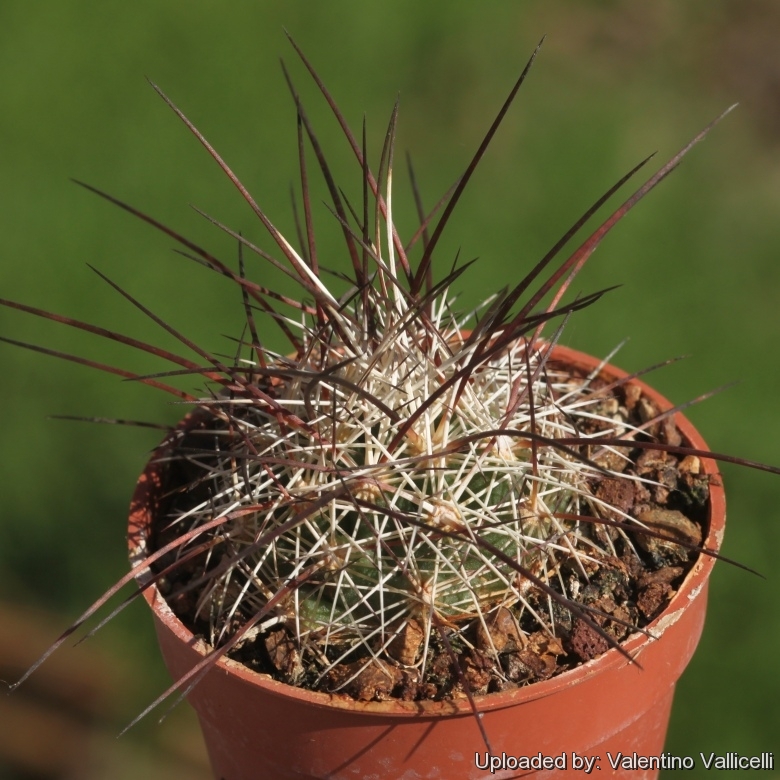
Coryphantha ramillosa Photo by: Valentino Vallicelli
Origin and Habitat: Coryphantha ramillosaSN|10403]]SN|10403]] has a wide range in southwest Texas along the Rio Grande in Brewster and southern Terrell counties, and on a substantial portion of northern Mexico on the neighboring Chihuahua and Coahuila.
Altitude: It occurs at elevations from 110 to 1,050 m asl
Habitat: Coryphantha ramillosaSN|10403]]SN|10403]] grows on calcareous soils in xerophyllous scrub and in the desert on bare rocky slopes, talus, or scree and also in Chihuahuan Desert succulent scrub on rocky slopes, ledges, and gravelly flats on Santa Elena or Boquillas limestones. The habitat of Coryphantha ramillosaSN|10403]]SN|10403]] is home to succulent flora and is particularly rich in local endemics such as: Agave lechuguillaSN|23013]]SN|23013]], Euphiorbia antisyphilitica, Fouqueria splendens, Jatropha dioica and Larrea tridentata. It is scarce (estimated population size of 2,500 to 100,000 individuals) and is collected in great quantities by commercial dealers for direct sale from the field, which results in a localized but substantial threat, however, that it is more widespread than originally thought and may not be threatened in most parts of its range.
Synonyms:
See all synonyms of Coryphantha ramillosa
Common Names include:
ENGLISH: Bunched Cory Cactus, Big Bend Cory Cactus, Whiskerbush, Whiskerbush pincushion Cactus, Big Bend Mammillaria, Bunched Cory-cactus, Big Bend Cory-cactus
Description: Coryphantha ramillosaSN|10268]]SN|10403]] is a small cactus species, appearing bristly or shaggy grey, brown, or whitish. Two subspecies are recognized, the typical form and subsp. santarosa Dicht & A.Lüthy.
Similar species: It is often difficult to distinguish from Coryphantha macromerisSN|10403]]SN|10268]].
Habit: It is a perennial stem succulent, predominantly solitary but sometimes branching to form clusters of up to 25 (or more) stems.
Roots: Diffuse or strong taproot one-fifth of stem diameter.
Stems: Deep-seated, hemispheric or spherical to broadly obovoid, often with flattened tips, grass green to dark grey-green, (1-)6-9 cm high, (3-)6-10 cm in diameter and not mucilaginous.
Tubercles: Conical, firm, ascending, 6-20 mm long and 6-9 (or more) mm wide, glands usually absent.
Areoles: About 3 mm in diameter at first with white wool, becoming linear and extending for 8-20 mm as grooves to axil of tubercles.
Spines: Partially obscuring the stem.
Central spines: (3-)4(-6), erect or spreading, straight to slightly curved, all thick and needle-like, sometimes shaggy or twisted, 17-43 mm long, 1 main central terete, straight, porrect, whitish to dark-brown, with golden bulbous base, noticeably projecting, 2-3 others, appressed upward in "bird-foot" pattern, longer whitish, greyish or dark-brown
Radial spines: (9-)13-16(-20), whitish or glaucous-greyish, sometime black-speckled, usually straight, sometime curving or twisting, often flattened, radiating like spokes (10-)12-30(-35) mm long.
Flowers: From young areoles near the apex, funnel shaped, colour varying from pale pink to deep rose purple with darker mid-stripe, glossy, 3.5-6.5 cm long, 3-5 cm in diameter. Outer perianth segments white, entire, upper one-half to one-third pink to purple. Filaments short, white. Anthers pale-yellow to orange. Stile and stigma-lobes white.
Blooming Season: It flowers opportunistically from August through November. Flowers open during the morning, close before sunset, and do not open again.
Fruits: Obovoid to spherical or elliptic, dark green to pale grey-green, very fleshy, 10-25 mm long and 20-10 mm wide. Floral remnant persistent.
Seeds: Yellowish to reddish-brown, glossy, spherical to kidney-shaped, 1-1,5 mm long and 1 mm wide.
Subspecies, varieties, forms and cultivars of plants belonging to the Coryphantha ramillosa group
 Coryphantha ramillosa Cutak: (subsp. ramillosa) has pale pink to deep rose purple flowers. Distribution: southwest Texas along the Rio Grande, and northern Mexico on the neighboring Chihuahua and Coahuila.
Coryphantha ramillosa Cutak: (subsp. ramillosa) has pale pink to deep rose purple flowers. Distribution: southwest Texas along the Rio Grande, and northern Mexico on the neighboring Chihuahua and Coahuila.- Coryphantha ramillosa subs. santarosa Dicht & A.Lüthy: has yellow flowers. Distribution: Coahuila, Mexico.
Bibliography: Major references and further lectures
1) Heil, K., Terry, M. & Corral-Díaz, R. 2013. Coryphantha ramillosa. In: IUCN 2013. “IUCN Red List of Threatened Species.” Version 2013.2. <www.iucnredlist.org>. Downloaded on 23 January 2014.
2) Reto Dicht, Adrian Lüthy “Coryphantha: Cacti of Mexico and Southern USA” Springer, 14/mar/2006
3) Edward Anderson “The Cactus family” Timber Press, Incorporated, 2001
4) James Cullen, Sabina G. Knees, H. Suzanne Cubey "The European Garden Flora Flowering Plants: A Manual for the Identification of Plants Cultivated in Europe, Both Out-of-Doors and Under Glass" Cambridge University Press, 11/Aug/2011
5) David R Hunt; Nigel P Taylor; Graham Charles; International Cactaceae Systematics Group. "The New Cactus Lexicon" dh books, 2006
6) Reto F. Dicht, Adrian D. Lüthy "A new conspectus of the genus Coryphantha." In: Cactaceae Systematics Initiatives. Number 11, 2001.
7) Urs Eggli, Leonard E. Newton “Etymological Dictionary of Succulent Plant Names” Springer, Berlin/Heidelberg 2010
8) Jackie M. Poole, William R. Carr, Dana M. Price, Jason R. Singhurst “Rare plants of Texas: a field guide” Texas A&M University Press, 30/Dec/2007
 Coryphantha ramillosa Photo by: Valentino Vallicelli
Coryphantha ramillosa Photo by: Valentino VallicelliSend a photo of this plant.The gallery now contains thousands of pictures, however it is possible to do even more. We are, of course, seeking photos of species not yet shown in the gallery but not only that, we are also looking for better pictures than those already present.
Read More... Cultivation and Propagation: In culture it is without problems, and regularly shows its large pink-purple flowers.It flowers quite early.
Exposition: It does best in light shade, but does well in full sun too.
Watering: It is sensitive to overwatering (rot prone).
Soils: Needs a very porous soil with good drainage.
hardiness: It tolerates fairly low temperatures as long as it is kept dry (hardy to -12° C for short periods of time).
Propagation: Propagation is by seed.











